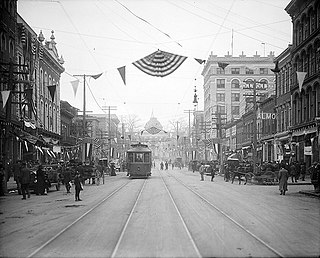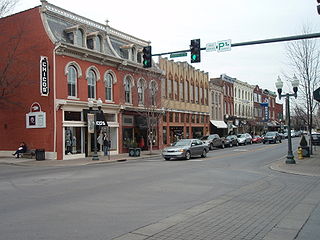
Edenton Historic District is a national historic district located at Edenton, Chowan County, North Carolina. The district encompasses 342 contributing buildings, 4 contributing sites, and 3 contributing structures. It includes several buildings that are individually listed on the National Register. The Lane House, possibly the oldest surviving house in North Carolina, is owned by Steve and Linda Lane and is located within the district. Also located in the district are the Dixon-Powell House, William Leary House, and Louis Ziegler House designed by architect George Franklin Barber.

The Fayetteville Street Historic District in Raleigh, North Carolina is a historic district listed on the National Register of Historic Places (NRHP). The District includes the 100-400 blocks of Fayetteville Street, the 00-100 blocks of the south side of West Hargett Street, the 00 block of the north side of West Martin Street, and the 100-400 blocks of South Salisbury Street.

Franklin Historic District is a historic district in Franklin, Tennessee that was listed on the National Register of Historic Places in 1972. It was created to preserve historic commercial and residential architecture in a 16-block area of the original, downtown Franklin around the north, west, and south of the town square.

The Wadesboro Downtown Historic District is a 32-acre (13 ha) national historic district located at Wadesboro, Anson County, North Carolina. It included 81 contributing buildings, one contributing structure and one contributing object in the governmental and commercial core of the City of Wadesboro. It includes work by architects Wheeler & Stern. Notable buildings include the Anson County Courthouse (1914), U.S. Post Office, the Boggan-Hammond House and Alexander Little Wing, the Burns Inn, Parsons Pharmacy, Leak's Hardware Company Building, and the Ansonia Theater.

Halifax Historic District is a national historic district located at Halifax, Halifax County, North Carolina, US that was listed on the National Register of Historic Places in 1970 with an increase in 2011. It includes several buildings that are individually listed on the National Register. Halifax was the site of the signing of the Halifax Resolves on April 12, 1776, a set of resolutions of the North Carolina Provincial Congress which led to the United States Declaration of Independence gaining the support of North Carolina's delegates to the Second Continental Congress in that year.

The American Tobacco Historic District is a historic tobacco factory complex and national historic district located in Durham, Durham County, North Carolina. The district encompasses 14 contributing buildings and three contributing structures built by the American Tobacco Company and its predecessors and successors from 1874 to the 1950s. Located in the district is the separately listed Italianate style W. T. Blackwell and Company building. Other notable contributing resources are the Romanesque Revival style Hill Warehouse (1900), Washington Warehouse (1902–07), the Lucky Strike Building (1901–02), and Reed Warehouse; Noell Building ; Power Plant and Engine House (1929–39); and the Art Moderne style Fowler (1939) Strickland (1946) and Crowe (1953) buildings.

Fort Mill Downtown Historic District is a national historic district located at Fort Mill, York County, South Carolina. It encompasses 16 contributing buildings, 1 contributing site, 1 contributing structure, and 4 contributing objects in the central business district of Fort Mill. The buildings are predominantly one and two-story masonry commercial buildings constructed between 1860 and 1940. The district includes the Confederate Park and its Bandstand. Notable contributing resources include the Confederate Soldiers Monument, Catawba Indians Monument, Faithful Slaves Monument, Jones Drug Store, and First National Bank / Old City Hall.

Black Mountain Downtown Historic District is a national historic district located at Black Mountain, Buncombe County, North Carolina. The district encompasses 56 contributing buildings and 1 contributing structure in the central business district of Black Mountain. The district includes a variety of late-19th and early-20th century commercial and institutional buildings in the Commercial Style, American Craftsman, Classical Revival, Art Deco and Art Moderne. Notable buildings include the George Stepp House (1907), Black Mountain Depot (1909), firehouse (1921) designed by Richard Sharp Smith, town hall (1927), Kaltman Building (1928), and Pure Oil Service Station.

Lenoir Downtown Historic District is a national historic district located at Lenoir, Caldwell County, North Carolina. The district includes 41 contributing buildings and 2 contributing objects in the central business district of Lenoir. It includes commercial, governmental, and institutional buildings in a variety of popular architectural styles including Art Deco, Art Moderne, Classical Revival and Tudor Revival. Notable contributing resources include the Center Theater (1941), O. P. Lutz Furniture Company and Lutz Hosiery Mill (1939), Dayvault's Drug Store (1937), Caldwell County Agricultural Building (1937), Courtney Warehouse, Masonic Hall, Miller Building, Confederate Monument (1910), Belk's Department Store (1928), Lenoir Building (1907), J. C. Penney Department Store, Fidelity Building (1928), and U. S. Post Office (1931). Located in the district is the separately listed Caldwell County Courthouse.

Liberty Row is a national historic district located at Fayetteville, Cumberland County, North Carolina. It encompasses 14 contributing buildings and 1 contributing site in the central business district of Fayetteville. The district includes consists of a block of 14 brick row buildings dating between 1791 and 1916. The Liberty Point Store is the oldest structure and is a two-story, five bay, Federal style brick building.

Market House Square District is a national historic district located at Fayetteville, Cumberland County, North Carolina. It encompasses 11 contributing buildings in the central business district of Fayetteville. The district includes six storefronts and a major store, an office building, a former Knights of Pythias Building, and the First Citizen's Bank Building, all of which date between 1884 and 1926 and ring the separately listed Market House. The First Citizen's Bank Building was designed by architect Charles C. Hartmann and built in 1926.

Haymount District, also known as Haymount Historic District, is a national historic district located at Fayetteville, Cumberland County, North Carolina. It encompasses 60 contributing buildings and 1 contributing site in a primarily residential section of Fayetteville. The dwellings were built between about 1817 and 1950, and include notable examples of Queen Anne and Colonial Revival style architecture. The earliest extant residence is the Robert Strange Town House, home of Senator Robert Strange (1796-1854). Another notable building is the Highsmith Memorial Hospital, designed by architect Charles C. Hartmann and completed in 1926. Also located in the district is the separately listed Edgar Allan Poe House.

Fayetteville Veterans Administration Hospital Historic District is a national historic district located at Fayetteville, Cumberland County, North Carolina. It encompasses 8 contributing buildings, 1 contributing site, 1 contributing structure, and 1 contributing object on the medical center campus. They include the main building/outpatient clinic (1939), service building (1939), manager's quarters (1939), attendants’ quarters (1939), laundry building (1939), the flag pole (1939), and the attendants’ quarters (1939). Also located in the district is the separately listed Confederate Breastworks.

Thomasville Downtown Historic District is a national historic district located at Thomasville, Davidson County, North Carolina. The district encompasses 46 contributing buildings, 1 contributing site, 2 contributing structures, and 2 contributing objects in the central business district of Thomasville. It includes commercial and governmental buildings built between 1871 and 1938. Located in the district is the separately listed Thomasville Railroad Passenger Depot. Other notable contributing resources include The Big Chair (1950), the former City Hall (1938), the former Davidson County Office Building, the former United States Post Office (1926), (former) Davidson County Office Building (1957), the Dr. Orien R. Hodgin Dental Office, the North State Telephone Warehouse, First National Bank of Thomasville (1922), C. R. Thomas Block, and the Lambeth Furniture Company/Thomasville Chair Company.

Downtown Durham Historic District is a national historic district located at Durham, Durham County, North Carolina. The district encompasses 97 contributing buildings and 1 contributing structure in the central business district of Durham. The buildings primarily date from the first four decades of the 20th century and include notable examples of Colonial Revival, Italianate, and Art Deco architecture. Notable buildings include the St. Philip's Episcopal Church (1907), Trinity Methodist Episcopal Church (1880-1881), First Baptist Church (1926-1927), Durham County Courthouse (1916), Durham Auditorium, Tempest Building, National Guard Armory (1934-1937), United States Post Office (1934), Trust Building (1904), First National Bank Building (1913-1915), Mechanics and Farmers Bank (1921), Johnson Motor Company showroom (1927), Hill Building (1935), Snow Building (1933), and S. H. Kress store.

Whitsett Historic District is a national historic district located at Whitsett, Guilford County, North Carolina. The district encompasses 38 contributing buildings, 1 contributing site, and 5 contributing structures in the crossroads village of Whitsett. The contributing resources were built between 1894 and 1921, and developed around the Whitsett Institute, that operated from 1884 to 1919. Located in the district and separately listed is Holly Gate. Other notable buildings include the Queen Anne / Colonial Revival style "The Oaks", the John Rankin House, the Captain Dick House, the Wimbish-Tayler House, the Jefferson Lamb Houses, the Swift-Wheeler House, and the 1894 Charles T. Mason House and Dormitory.

Greenville Tobacco Warehouse Historic District is a national historic district located at Greenville, Pitt County, North Carolina. The district encompasses seven contributing buildings and one contributing structures in an industrial section of Greenville. It includes buildings dated from about 1905 to 1947 and notable examples of Art Deco and Italianate style industrial architecture. Contributing resources are the American Tobacco Company Storage Warehouse #2. ; the Prichard-Hughes Warehouse ; the Dail-Ficklen Warehouse ; the Export Leaf Factory ; the E. B. Ficklen Factory ; the Gorman Warehouse (1927); the Star Warehouse (1930); and the System of CSX Railroad Tracks.

Ellis Street Graded School Historic District is a national historic district located at Salisbury, Rowan County, North Carolina. The district encompasses 76 contributing buildings and 1 contributing structure in a predominantly residential section of Salisbury. They were built between about 1867 and 1948, and include notable examples of Italianate and Bungalow / American Craftsman style architecture. Notable contributing resources include the Ellis Street Graded School building (1881) and Shober Bridge.

Downtown Elkin Historic District is a national historic district located at Elkin, Surry County, North Carolina. The district encompasses 51 contributing buildings and 2 contributing structures in the central business district of Elkin. They were primarily built between about 1890 and 1950 and include notable examples of Early Commercial and Bungalow / American Craftsman architecture. Notable buildings and structures include the Gwyn-Foard House, Hugh G. Chatham Bridge (1931), Liberty Tobacco Warehouse, Harris Building (1902), U.S. Post Office (1937) designed by the Office of the Supervising Architect under Louis A. Simon, former Elkins Town Hall (1938–1939) built by the Works Progress Administration, Dobbin's Store, and the Riverside Hotel (1915–1925).

Downtown Wake Forest Historic District is a national historic district located at Wake Forest, Wake County, North Carolina. The district encompasses 25 contributing buildings, 1 contributing structure, and 1 contributing object built between about 1890 and 1949 and located in the central business district of the town of Wake Forest. It includes notable examples of Colonial Revival and Art Deco style architecture. Notable buildings include the Lovelace Building (1940s), Dick Frye Restaurant (1940s), Powers-Barbee Building, Wilkinson Building (1899), B&S Department Store, Arrington Building (1915), Bank of Wake (1895), Wake Forest Post Office (1914), Collegiate Theater (1915), and Wake Forest Post Office (1940).























